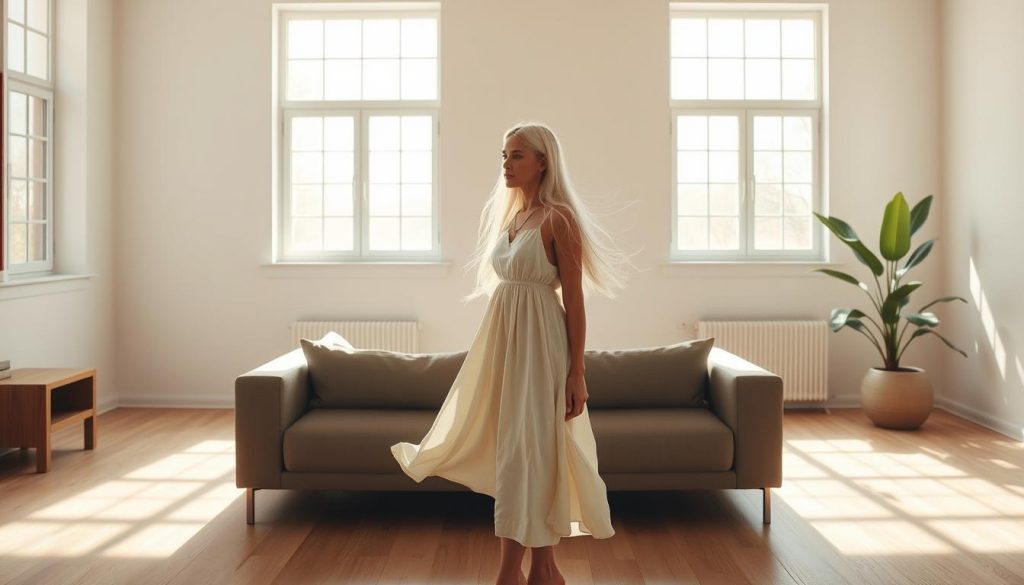Minimalism Aesthetic Curious how “less” can make life feel fuller? I hear you! You want calm, focus, and clearer choices. This section breaks down the term so you can use it with confidence and start seeing results fast!
The minimalist aesthetic blends clean design, neutral colors, and fewer distractions. It draws from Japanese and Scandinavian roots and from art movements that valued space and essentials. In practice, this concept shows up in tidy rooms, capsule wardrobes, and daily habits that remove what doesn’t serve you.
I’ll show how people use this idea to create calm at home and in their routines. This isn’t about rules or perfection. It’s about smarter choices that help you feel lighter every day. Ready to make “less but better” your new normal? Let’s get started!
Key Takeaways
- You’ll gain clarity by focusing on essentials and clean design.
- The concept combines visual style with lifestyle habits.
- Roots include Japanese traditions and modern art movements.
- Small changes create immediate calm in home and routine.
- This term is practical—aim for better choices, not perfection.
- You can apply ideas quickly with clear, simple steps!
Minimalism Aesthetic defined today: clarity, calm, and fewer distractions
You can see clarity in a space that uses neutral tones and clean surfaces. This simple look helps your mind slow down and your day feel easier.
What it means in plain terms: choose items you use and love. Let go of extra objects that only take up visual space. Neutral wall colors like white, gray, or beige make a room feel open and gentle on the eyes.
Core elements include clean lines, open space, and few distractions. Use light textures and intentional pieces so your home feels calm the moment you walk in. Try the “spark joy” test to edit belongings: keep what matters and remove what doesn’t.
“Less is more” matters now because constant pings and feeds drain attention and energy.
- Clean design reduces visual noise and helps you focus.
- Open space gives instant mental ease after a long online day.
- Start small: clear one surface, keep only useful or meaningful items.
From art movement to lifestyle philosophy: the roots of a minimalist aesthetic
Bold reduction in art taught people to notice space, silence, and the power of one object. That history helps explain why this design concept feels so alive today.

Origins in Minimal Art
Early modern art shook things up. Kazimir Malevich’s Black Square stands as one clear example of radical reduction. Mid-century Minimal Art then pushed back against dramatic gestures. Artists focused on sober forms and the viewer’s role. You meet the work halfway, and your reaction finishes the piece.
Eastern influences and essentials
Japanese and Korean traditions long favored essentials in craft, architecture, and daily life. Those practices shaped how people think about space and calm. Simple rituals and pared-down objects teach attention and ease.
Space for contemplation
The core concept is giving room to think. When you strip away decoration, an object or a spare wall can hold more meaning. That space invites reflection and personal interpretation.
“Less that invites deeper engagement—art and rooms that don’t shout, so your mind can explore.”
- Art proved less can speak volumes.
- One strong form can change how you feel and think.
- The viewer completes the work, just like your choices complete your home.
| Origin | Focus | Impact on people |
|---|---|---|
| Malevich & early modern art | Radical reduction | New way to feel a work’s presence |
| Mid-century Minimal Art | Sober objects, viewer engagement | Demanded active viewing |
| Japanese & Korean traditions | Essentials, ritual, calm | Shaped daily lifestyle and design |
Bringing a minimalist aesthetic into your space, style, and life
A few clear edits to your home and wardrobe can free tons of time and energy. Start with small, practical moves that fit your actual day. You’ll see results fast!

Minimalist home design: neutral palettes and smart furniture
Repaint walls in white, gray, or beige. Choose clean-lined furniture and simple textures for calm rooms.
Scandinavian-inspired pieces are a great place to start. Curate a few intentional objects so each surface helps you, not distracts you.
Practical example: edit with “Does it spark joy?” and “Do I use this?”
Ask both questions when you sort items. Keep what sparks joy and what you use every day.
Honor reality: if you cook often, keep extra pots. That way your minimalist home supports life, not chores.
Personal style and lifestyle shifts
Build a capsule wardrobe with neutral base layers and smaller jewelry. Rotate favorites seasonally to save time.
Journal to spot energy drains. Add short meditation, yoga, or walks to clear your head and reset your life.
“Small, daily choices compound into big wins for your time, your mood, and your life.”
- Ten-minute evening resets keep your home usable each morning.
- Design for use, not a feed—tailor choices to your routine.
- Avoid comparison; aim for progress, not perfection!
| Area | Quick step | Benefit |
|---|---|---|
| Walls & color | Repaint in white, gray, beige | Opens space and soothes the eye |
| Furniture | Pick clean-lined, neutral pieces | Easy upkeep and timeless look |
| Objects & items | Edit with joy + use test | Less clutter, more function |
| Lifestyle | Journal + short movement | Better focus and more time |
Conclusion
Clear choices simplify life and free real time for what matters! Clear choices at home cut noise and invite calm. Focus on useful items. Let your day start lighter and brighter.
Example: keep the five pots you actually use. Release extras that only take space. Small edits like this add up fast!
You’ve seen how these aesthetics come from art, craft, and practical habits. Protect your time with quick nightly resets and simple systems. Style it your way—your needs lead, not rules or comparison!
Take one focused change today. You’ll create more ease, clarity, and room to make and connect. Go for less but better—and enjoy the results!
Elevate your spiritual journey with Conscious Items’ genuine gemstones, trusted by thousands and backed by a 30-day money-back guarantee. Don’t let these powerful crystals pass you by—stocks are limited, and the perfect one for you is waiting! Visit Conscious Items now to find your crystal match before it’s too late.
If you liked reading this article you will love this article Minimalism Checklist: The ONLY Checklist you need
Morganite Crystal Healing Properties
Habits of Healthy Relationships: 10 Keys to Lasting Love: The Ultimate Love Stone for Heart Healing
FAQ



